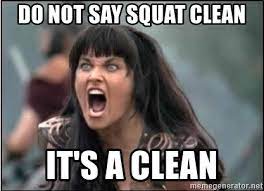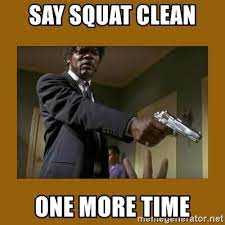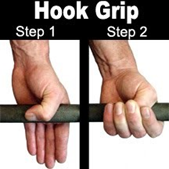Weightlifting Terminology
by Erik Castiglione
“Weightlifting,” when written as 1 word, is the sport performed in the Olympics. It’s also referred to as Olympic weightlifting. “Weight lifting,” written as 2 words, refers to lifting weights. It is also called “weight training.” “Weightlifting” is comprised of the Olympic lifts, which are also known as the “Classic Lifts.” They are the snatch, clean, and jerk. That’s it. The lifts used to build the classic lifts, such as presses, pulls, and squats, are known as strength lifts. So, we have the strength lifts, and the classic lifts. And it’s the classic lifts that tend to cause the most confusion. What’s the difference between a hang clean, a power clean, and a hang power clean? Let’s break it down.
When it comes to the classic lifts, the names are very systematic. If you can learn the terms, we can throw a movement at you that you’ve never done, and based on the name alone, you’ll know what to do. Here’s how to crack the system:
Step 1: Look for the name of the lift. For our purposes at Viking Athletics, it will either be “snatch” or “clean.” This will determine your grip width, and whether the bar ends overhead or on your shoulders, if not performing a drill.
Step 2: Determine whether you’re performing a drill. Look for a word following “snatch” or “clean.” If you see anything there, you’ll adjust the end position of the bar accordingly. For example, a “pull” ends with the bar at the waist.
Step 3: Find your end position (only applicable if step 2 doesn’t show a drill). Look before the name of the lift to find an end position. We have 3 possible end positions: muscle, power, and squat. Our default end position is in a squat, and it is not explicitly stated. If you’re not performing a drill, and you don’t see the words “muscle” or “power,” you end in a squat.
Step 4: Determine your start position. This term appears before the name of the lift as well. If there is a single term before the name of the lift and it isn’t “muscle” or “power,” we know that it’s a start position by process of elimination. If there are two terms before the name of the lift, the first is the start position, and the second is the end position. Start position examples include “tall,” “hang,” and “high hang.” If no start position is specified, the bar starts on the floor by default. The full lift is a “snatch” or “clean,” you’d never call it a “floor squat snatch” or “floor squat clean.”
Here’s a handy table to summarize the 4 steps:
| Term 1: Start Position | Term 2: End Position | Term 3: Name of Lift | Term 4: Drill |
| Floor (default pos.) | Muscle | Snatch | Pull |
| Below Knees | Power | Clean | High Pull |
| Hang | Squat (default pos.) | Jerk | Balance |
| High Hang | Drop | ||
| Tall | Etc. |
Now for some additional terms and illustrations:
Hook Grip: Thumb wrapped around bar; fingers wrapped on top of thumbs. Used in snatch and clean.
Snatch: Lift the bar from starting position up overhead in one fluid, explosive motion. Wide grip.
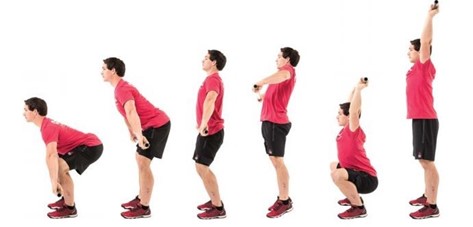
Clean: Lift the bar from the starting position to the shoulders in one fluid, explosive motion. Grip just outside the shoulders.
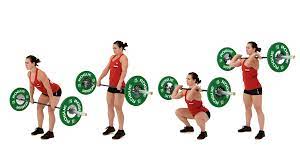
Jerk: Lift the bar from the shoulders up overhead while simultaneously dropping under it to the landing position. Grip just outside the shoulders.
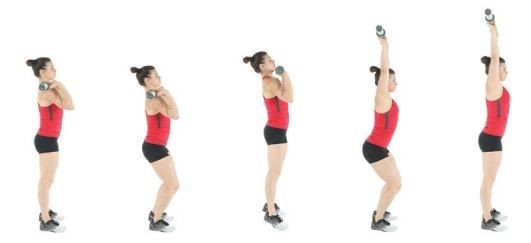
Starting Positions:
Picture 1- Floor: Bar starts on the floor. This is the default starting position if no other is specified.
Below the Knee (not shown): The bar starts below the knees with plates off the ground. This is lower than a hang.
Picture 2 – Hang: Bar starts above the knees.
Picture 3 – High Hang: Bar starts at the pockets.
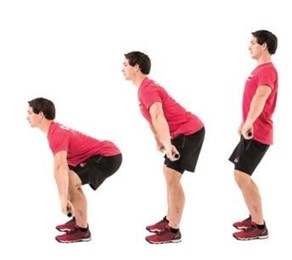
Finish Positions:
Muscle: Athlete receives the bar standing tall, without moving feet or re-bending the knees.
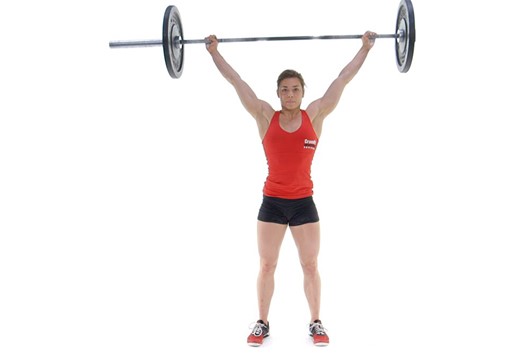
Power (AKA Push for Jerk): Athlete receives the bar in a quarter squat.

Squat: Default receiving position; use this unless another receiving position is specified – athlete receives the bar in a full depth squat.
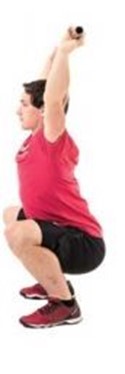
Split: Athlete receives the bar in a split position – front shin vertical, heel off the ground, back knee bent
Drills:
Pull: Instead of completing the lift, stand up hard, shrug, squeeze glutes, with the bar ending at the waist.
High Pull: Instead of completing the lift, stand up hard, shrug, squeeze glutes, pull elbows high and outside the shoulders, with the bar ending at chest height.
Balance: Drop to finish position from standing position, practicing speed under the bar.

